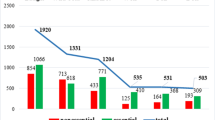Abstract
There is little data on the elemental composition of wild animals fur. In the paper, an attempt has been made to evaluate the concentration of elements in the fur of roe deer, wild boar and hare. The contents of following elements: calcium (Ca), magnesium (Mg), zinc (Zn), copper (Cu), iron (Fe), manganese (Mn), lead (Pb), cadmium (Cd), aluminium (Al), chromium (Cr), nickel (Ni) were determined by atomic absorption spectrometry method. Their content was in the range 0.01 (Cd) to 1,519 (Ca) μg/g. Correlations between the content of Mn, Al, Ca, Pb, Cr, Ni in the fur of animals, liver and muscle tissues were found. Thus it can be assumed that the fur of wild animals can provide an information on the bioavailability of elements and environmental exposure and can be considered as an useful biomarker in animals and environmental studies, although research on this subject should be continued.
Similar content being viewed by others
References
Asano K, Suzuki K, Chiba M, Sera K, Asano R, Sakai T (2005) Twenty-eight element concentrations in mane hair samples of adult riding horses determined by particle-induced X-ray emission. Biol Trace Elem Res 107:135–140
Budzyńska M, Krupa W, Sołtys L, Sapuła M, Kamieniak J, Budzyński M (2006) Level of bio-elements in purebred Arabian horses’ hair. Ann UMCS (sectio ee) XXIV(28):199–207
Chyla M, Żyrnicki W (2000) Determination of metal concentrations in animal hair by the ICP method. Comparison of various washing procedures. Biol Trace Elem Res 75:187–194
Combs DK (1987) Hair analysis as an indicator of mineral status of livestock. J Anim Sci 65:1753–1758
Długaszek M, Kopczyński K (2011) Comparative analysis of liver mineral status of wildlife. Probl Hig Epidemiol 9(4):859–863
Długaszek M, Kopczyński K (2012) Application of atomic absorption spectrometry in environmental monitoring based on comparative analysis of element contents in red fox tissues. Proc Electrotech Inst 255:19–28
Długaszek M, Kopczyński K (2013) Elemental composition of muscle tissue of wild animals from central region of Poland. Int J Environ Res 7(4):973–978
Długaszek M, Kaszczuk M, Mularczyk-Oliwa M (2012) Application of atomic absorption spectrometry in the elements and heavy metals determination in biological media-human hair. Proc Electrotech Inst 255:345–355
Filistowicz A, Dobrzański Z, Przysiecki P, Nowicki S, Filistowicz A (2011) Concentration of heavy metals in hair and skin of silver and red foxes (Vulpes vulpes). Environ Monit Assess 182:477–484
Gabryszuk M, Słoniewski K, Metera E, Sakowski M (2010) Content of mineral elements in milk and hair of cows from organic farms. J Elementol 15(2):259–267
Goullé JP, Mahieu L, Castermant J, Neveu N, Bonneau L, Lainé G, Bouige D, Lacroix C (2005) Metal and metalloid multi-elementary ICP-MS validation in whole blood, plasma, urine and hair, reference value. Forensic Sci Int 153:39–44
Gunstheimer G, Gunstheimer U, Anke M (1996) The red fox as a bioindicator of mercury exposure. In: Proceedings of the XXII congress of the international union of game biologists (IUGB), PENSOFT, Sofia, pp 439–443
Jones RL (2002) Zinc, iron, and sodium in hair of deer from areas of contrasting soil productivity. Biol Trace Elem Res 86:217–226
Kempson IM, Lombi E (2011) Hair analysis as a biomonitor for toxicology, disease, and health status. Chem Soc Rev 40:3915–3940
Lin Ch-J, Wu M-H, Hsueh Y-M, Sun SS-M, Cheng A-L (2005) Tissue distribution of arsenic species in rabbit after single and multiple parenteral administration of arsenic trioxide: tissue accumulation and the reversibility after washout are tissue-selective. Cancer Chemother Pharmacol 55:170–178
Medvedev N (1999) Levels of heavy metals in Karelian wildlife, 1989–91. Environ Monit Assess 56:177–193
Rashed MN, Soltan ME (2005) Animal hair as biological indicator for heavy metal pollution in urban and rural areas. Environ Monit Assess 110:41–53
Sobańska MA (2005) Wild boar hair (Sus scrofa) as non-invasive indicator of mercury pollution. Sci Total Environ 339:81–88
Wren CD (1986) Mammals as biological monitors of environmental metal levels. Environ Monit Assess 6:127–144
Author information
Authors and Affiliations
Corresponding author
Rights and permissions
About this article
Cite this article
Długaszek, M., Kopczyński, K. Correlations Between Elements in the Fur of Wild Animals. Bull Environ Contam Toxicol 93, 25–30 (2014). https://doi.org/10.1007/s00128-014-1260-3
Received:
Accepted:
Published:
Issue Date:
DOI: https://doi.org/10.1007/s00128-014-1260-3




